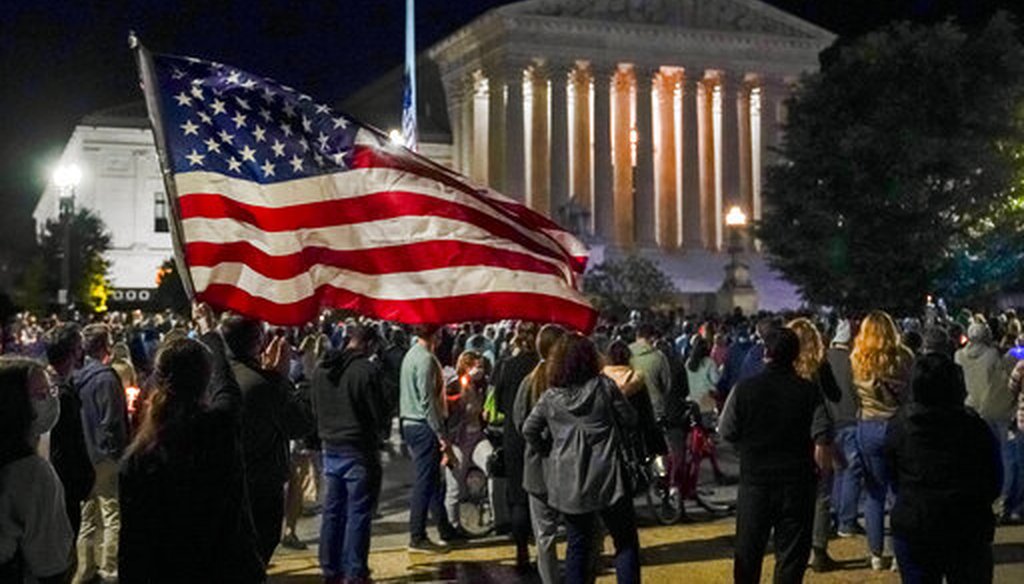Stand up for the facts!
Our only agenda is to publish the truth so you can be an informed participant in democracy.
We need your help.
I would like to contribute

People gather at the Supreme Court on Sept. 19, 2020, to honor the late Justice Ruth Bader Ginsburg. (AP)
If Your Time is short
• The timing of a vote on a nominee could depend on dueling priorities for Senate Majority Leader Mitch McConnell: filling judicial vacancies with conservatives, and protecting vulnerable senators up for election who are crucial for his control of the chamber.
• Current Senate rules call for a simple majority vote on Supreme Court nominees.
• The Senate could push a vote on the nominee past Election Day. If Democrats win enough seats in the election to take over the Senate, McConnell would need to act no later than Jan. 3, when the new Congress is sworn in.
The death of Supreme Court Justice Ruth Bader Ginsburg was always expected to set up a huge political battle over confirming her replacement. With her death coming so close to the election, the process has become even more fraught.
Because they control the presidency and the Senate, Republicans have the power to install a successor to the right of the liberal icon, with potential consequences for the Affordable Care Act and the Roe vs. Wade decision that allows abortion.
Democrats argue that it is hypocritical for Republicans to fill a Supreme Court vacancy that opened 46 days before Election Day, especially if it’s done after a possible Republican loss of the presidency and the Senate majority.
In 2016, Republicans blocked President Barack Obama’s nomination of Merrick Garland to fill the vacant seat of Antonin Scalia, who died in February of that year. There were 238 days between Garland’s nomination and Election Day.
The Ginsburg vacancy is the second closest to an election in Supreme Court history. In 1864, Chief Justice Roger Taney died 27 days before Election Day and his seat was not filled until after Election Day. The latest seat filled prior to an election, vacated by Justice Charles Evans Hughes, was in 1916, and the vacancy emerged 149 days before the election.
Typically it takes about 70 days from nomination to confirmation. On the current court, Brett Kavanaugh was confirmed in 89 days, Neil Gorsuch in 66 days, Elena Kagan in 87 days, Sonia Sotomayor in 72 days, Samuel Alito in 92 days, John Roberts in 72 days, and Stephen Breyer in 77 days. Ginsburg’s confirmation took 50 days.
As President Donald Trump prepares to announce his pick for a third Supreme Court justice, we decided to review the process of how Supreme Court vacancies are filled, and how the 2020 election could influence those steps.
President Donald Trump has indicated that he’ll be making a nomination within days.
The Senate is free to ignore the nomination, but in this case it’s expected to pursue confirming Trump’s nominee.
The Republicans currently control the chamber’s agenda, and Senate Majority Leader Mitch McConnell, R-Ky., tweeted shortly after Ginsburg’s death that Trump’s nomination "will receive a vote on the floor of the Senate."
In theory, the final vote could begin once the Senate formally takes up the nomination. But historically, the Senate takes intermediary steps, such as the Senate Judiciary Committee holding public hearings. Usually, nominees meet with senators while the committee investigates the nominee’s background.
Given the already rushed nature of the nomination, "skipping these steps would make the nomination seem even less legitimate," said Gregory Koger, a University of Miami political scientist.
The Republicans have a majority on the Judiciary Committee, and the chair, Sen. Lindsey Graham of South Carolina, has said he’ll take up Trump’s nomination in committee. (This is a reversal from a position he stated as recently as 2018.)
Because nomination battles are highly partisan, both parties’ lineups on the committees tend to include a lot of party loyalists. But the politics of the 2020 election could complicate matters: Not only is Graham facing a strong challenge this year, but so are fellow Republicans Thom Tillis of North Carolina and Joni Ernst of Iowa. Uncritical support for Trump’s nominee could energize Republican base voters in their states, but could turn off swing voters. Another member of the committee is Sen. Kamala Harris, D-Calif., who is Democratic presidential nominee Joe Biden’s running mate.
After the president names his pick, McConnell would make a motion to bring up the nomination in the Senate, which would likely trigger a vote.
The nomination would be subject to cloture, a tool to cut off a potential filibuster. However, in recent years, both parties have pared back the threshold to end filibusters on nominations. Most recently, the Republicans voted to reduce the number of votes required to cut off debate for a Supreme Court nomination from 60 to a simple majority. The lower threshold was used for the first time with the nomination of Gorsuch, who was Trump’s replacement for Garland in filling Scalia’s seat.
Once a majority votes to take up the nomination, there would be 30 hours of debate on the nomination. No senator may speak for more than an hour, and every senator is guaranteed at least 10 minutes.
The current partisan breakdown is 53 Republicans and 47 Democrats or Democratic-aligned independents. If the Democrats manage to convince three Republicans to oppose the nomination, that still wouldn’t be enough, because Vice President Mike Pence, as president of the Senate, would be able to cast a tie-breaking vote for Trump’s nominee. So the Democrats would need at least four Republicans to break ranks.
Until Pence cast a tie-breaking vote to confirm Education Secretary Betsy DeVos in 2017, no vice president had cast a tie-breaking vote on a presidential nomination since 1862, said Steven S. Smith, a political scientist at Washington University in St. Louis.
Republicans may decide to proceed with committee hearings but hold off on a vote until after the election, in a lame-duck session. (A lame-duck session happens after the election but before new senators take their seats for the next Congress.) "Nothing prevents consideration of nominations during a lame-duck session," Smith said. "Any senator sworn into office at the time of the relevant votes may vote."
Already, Republican Sens. Susan Collins of Maine and Lisa Murkowski of Alaska have said they do not want a vote on a nominee prior to the election. Other Republican senators had previously said they opposed filling the vacancy when it was only theoretical but have not yet said what they want since Ginsburg’s death.
The outcome of Arizona’s Senate race is another factor if the nomination were to be taken up after Nov. 3. Sen. Martha McSally, R-Ariz., was appointed to her position, and if she loses to Democrat Mark Kelly, who currently leads in the polls, he could be seated for that lame-duck session. That would trim the GOP majority to 52-48, and lower the number of breakaway Republicans needed by Democrats to three.
Also worth noting: McConnell’s timeline for action extends only to Jan. 3, when the new Congress will be sworn in. If the Democrats have enough votes to take the majority, they will do so on that day. Pence is guaranteed to serve as the tie-breaking vote until noon on Jan. 20, when either Trump or Biden is sworn in as president.
If the Democrats sweep to the presidency and win enough Senate seats to capture the majority on Election Day, they could argue that confirming a Trump nominee would run directly counter to the voters’ wishes. That would be an especially potent argument if votes to confirm the Trump nominee were cast by senators who have already lost their seats.
This scenario would increase pressure among Democrats to counter what they’d see as two stolen Supreme Court seats — Scalia’s and Ginsburg’s. Democrats may push legislation to add seats to the Supreme Court, and if they have the majority and the presidency, they would have a reasonable shot at doing so.
Doing this would require ending the filibuster. "The main obstacle would be a Senate filibuster, and with every passing day, the Democrats' will to revise the filibuster grows," Koger said. Democrats could also push for statehood for the District of Columbia and Puerto Rico, which would add four seats to the Senate, several of which might become Democratic-held.
"A lot is at stake," Smith said.
Our Sources
U.S. Senate, "Supreme Court Nominations (1789-Present)," accessed Sept. 20, 2020
Congressional Research Service, "Senate Consideration of Presidential Nominations: Committee and Floor Procedure," April 4, 2019
Congressional Research Service, "The First Day of a New Congress: A Guide to Proceedings on the Senate Floor," Dec. 19, 2018
U.S. Senate, partisan breakdown, accessed Sept. 20, 2020
Mitch McConnell, tweet, Sept. 18, 2020
Senate Judiciary Committee members, accessed Sept. 20, 2020
New York Times, "Ginsburg Supreme Court Vacancy Is the Second Closest to a U.S. Election Ever," Sept. 19, 2020
Associated Press, "AP Explains: What’s next with the Supreme Court vacancy?" Sept. 19, 2020
CNN, "Here's how long it's taken to confirm past Supreme Court justices," Sept. 19, 2020
CNN, "Key GOP senator says she opposes taking up a Supreme Court nomination before Election Day," Sept. 20, 2020
Financial Times, "Trump to nominate successor to Ginsburg next week," Sept. 19, 2020
Fox News, "Lindsey Graham sides with Trump on filling Supreme Court vacancy: 'I fully understand,'" Sept. 19, 2020
Fox News, "Susan Collins says she opposes voting on SCOTUS nominee before election," Sept. 19, 2020
Mother Jones, "A Long List of GOP Senators Who Promised Not to Confirm a Supreme Court Nominee During an Election Year," Sept. 18, 2020
Email interview with Steven S. Smith, political scientist at Washington University in St. Louis, Sept. 19, 2020
Email interview with Gregory Koger, University of Miami political scientist, Sept. 19, 2020
































